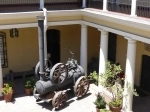National Historical Museum from Santiago. Santiago - CHILE
Direccion:
Plaza de Armas 951, Santiago Phone: +56 2411 7000
Web:
http://www.museohistoriconacional.cl/sitio/ Exhibition:
The National Historical Museum in its 18 permanent exhibition halls, recreates much of the history of Chile, while counting with an important heritage collection, which can be highlighted furniture, costumes, paintings, coins, photographs, weapons, items archaeological, and so on. These, along with scale models and recreations, Sutent museum discourse to understanding the different historical processes that have transpired in our country.
Location:
The National Historical Museum is located opposite the Plaza de Armas in Santiago (main Square), occupying the old Palace of the Royal Audiencia in the middle of the sidewalk north of the Plaza.
His address: Plaza de Armas 951. Metro Station Plaza de Armas.
History:
In the context of the centenary celebrations of independence President Ramón Barros Luco issued on 2 May 1911 a decree creating the National Historical Museum. However, the origin of the institution dates back to the early republic.
In July 1813, during the Old Country, the Senate approved a curriculum that saw the creation of the National Institute, the National Library and Museum of Science, among others. A Senate committee gave the task of creating a museum in a room at the Royal University of San Felipe, gathering there all the material considered important, from the Convictorio Carolina Academy of St. Louis and the Theological Seminary. Later, during the Reconquista, the Spanish government rejected all ideas raised during the Old Country by the Patriots, ending with this draft and the fledgling museum collections that had begun collecting. During the government of Bernardo OHiggins in 1822, resurrected the idea of forming a national museum, that would account for all characteristics of the territory and its inhabitants, French mission to the intellectual Dauxion José Francisco, who, shortly thereafter in his work, died in Santiago in 1829, without specifying its purpose.
By the year 1830 and under the rule of Vice President Jose Tomas Ovalle, was hired French scientist Claudio Gay, to take charge of exploring the country, publish their research and found a museum. In this way, and from the objects collected by Gay in his voyages of exploration was born the National Museum, which occupied some units of the National Institute, then located in one corner of Bandera and Cathedral streets.
In 1873, on the occasion of the anniversary celebrations of Chile, was organized an exhibition of ancient artifacts, known as the Exhibition of colonialism, with the intention of recalling the past history of our country, an initiative that was awarded to the then Mayor of Santiago, Benjamín Vicuña Mackenna, whose headquarters was in the old Palace of the Governors (now the site is occupied by the Post Office). The exposure led to the intelligentsia of the time to draw attention to the need to establish a historical museum permanently.
Thus in 1874 in Castle Hill, located on the north face of Cerro Santa Lucia, was installed the new Historical Museum, created from some donations of objects that were part of the Exhibition of colonialism.
By 1876 and following the appointment of Miguel Luis Amunátegui as Minister of Public Instruction, the Museum increased its collection, thanks to the interest of the young minister to go build the history of Chile through objects, paintings and sculptures representing famous people of the history. He was born this way, inside the museum, the Hall Historical Museum.
After the death of Vicuña Mackenna, 1886, the museum of the hill began to decline so that their libraries began to spread among government departments and some deposits of the State, making the nonchalance and disinterest destroy the dream of the said Mayor and Castle Hill become a municipal warehouse.
During the first decade of the twentieth century and soon to commemorate the centenary of Chile, the intellectual, Luis Montt Montt, then Director of the National Library, suggested organizing a new historical exhibition on the occasion of the celebrations to residents and although he died suddenly in late 1909, the interest in this new exhibition prompted other intellectuals who continued with this purpose. This is how the centennial celebrations for the exhibition was ready, as its headquarters the former Urmeneta family mansion (located at Mojitos Street between San Antonio and Mac iver), with a much larger number of objects to display in the exhibition colonialism and also has a great public success. This prompted organizers to petition the government for signing the decree that would create the National Historical Museum, a May 2, 1911, was President of the Republic Ramón Barros Luco and through the efforts of Senator Joaquin Figueroa, who moved to be chairman of the board of the Museum and considered its founder.
Shortly afterward, joined the museum's collection of weapons from the arsenals of war the army, the objects in the Museum of Santa Lucia and Historical Gallery National Museum, later were added to the collections of the Ethnographic Museum. Despite their abundant and valuable collections, the National Historical Museum was never able to display them together, largely for reasons of physical space. At first some units occupied the Palace of Fine Arts and later others were part of the National Library.
During this period the museum's collections to other institutions were disintegrating, reducing in turn the role that this institution had achieved at great effort. The need by the museum to have a permanent headquarters building that was for display and safekeeping of the collections, which by 1977 was responsible for the institution put their eyes on the old building of the Royal Court, opposite the Plaza de Armas. This involved rebuilding the palace, a task that was developed in four years. Thus, in September 1982, opened the Palace of the Royal Court as the new headquarters of the National Historical Museum, a place that not only tells the history of Chile, if not also aspires to be the face of our past and ourselves in the future.









